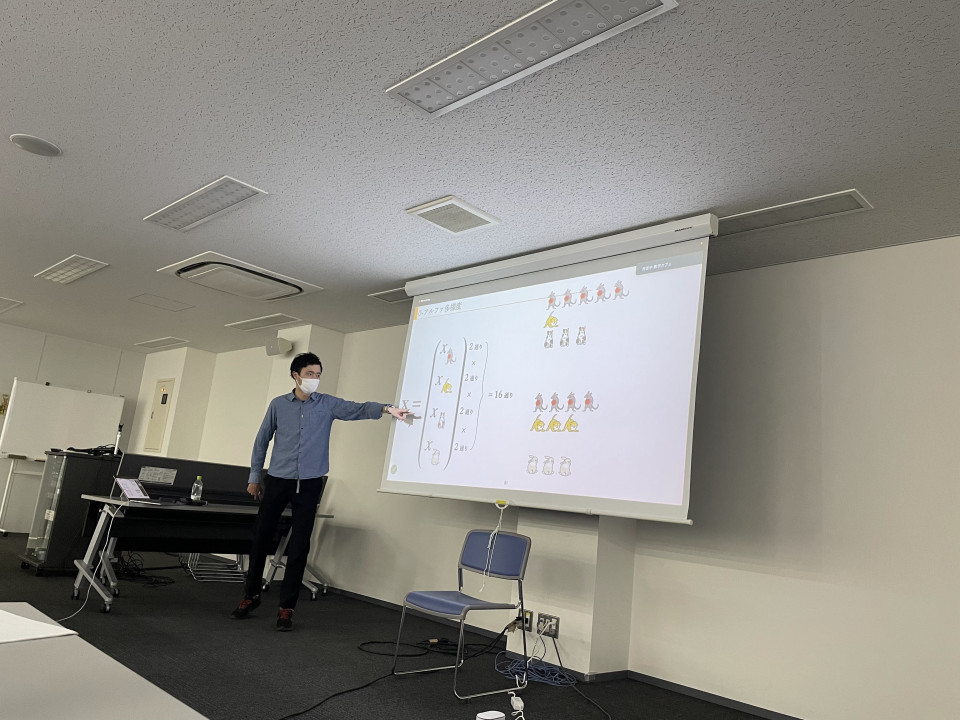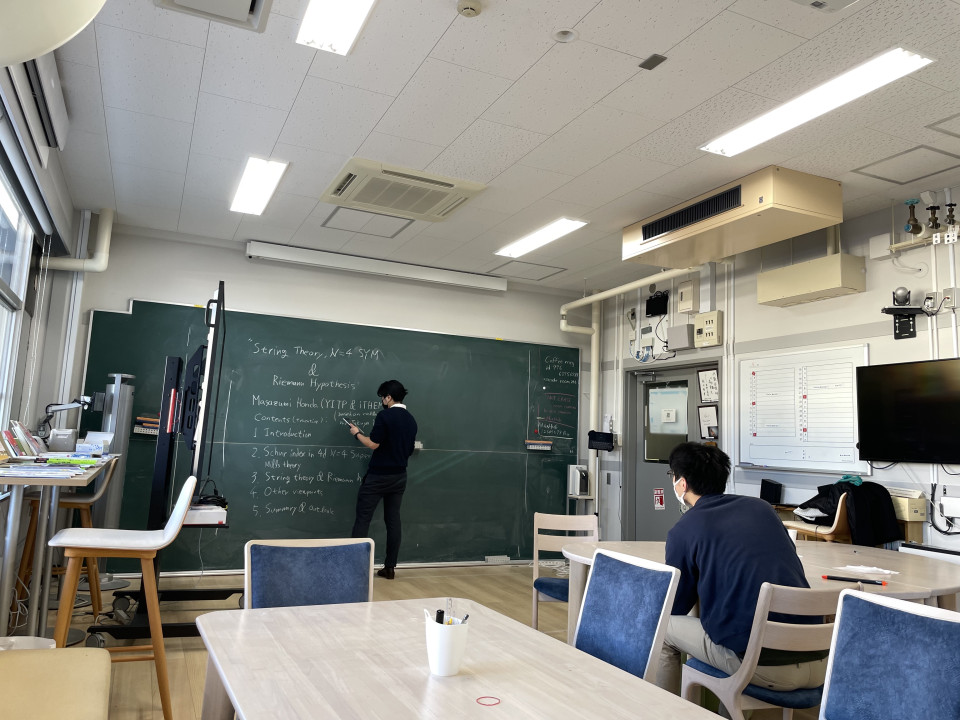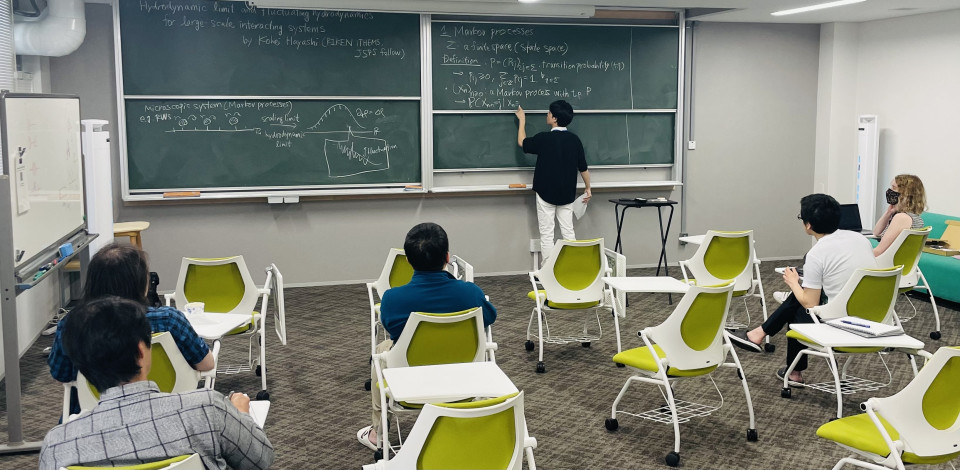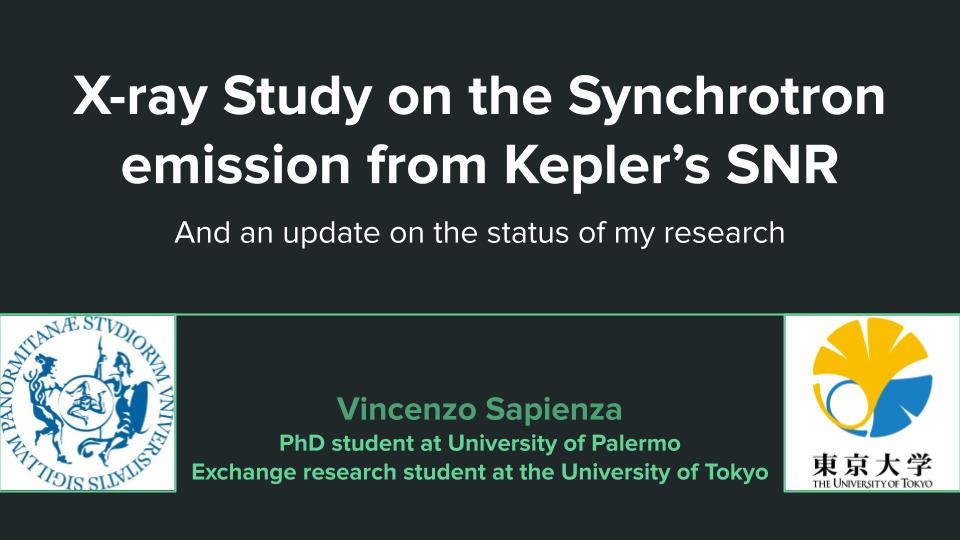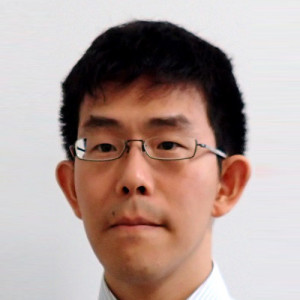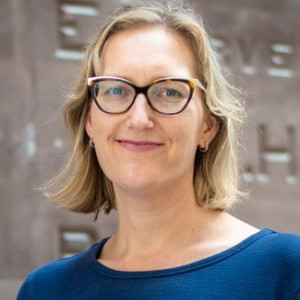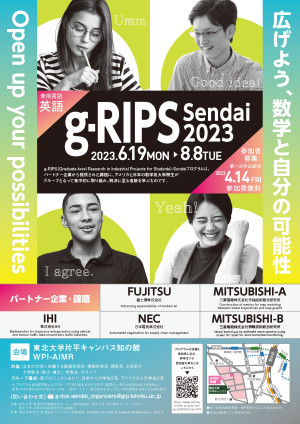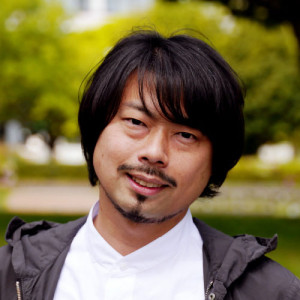Volume 252
Back to Newsletter List
Hot Topic
Ryosuke Iritani gave a scientific outreach talk at Mathcafe on May 14, 2023
2023-05-22
On Sunday 14th May, Ryosuke Iritani gave a scientific outreach talk at Mathcafe. He focused on spatial biodiversity as a chief topic and how to use mathematics to estimate, and make inferences for, the biodiversity. He explained the measurement of biodiversity from the axiomatic viewpoint, that is, he explained what properties should be satisfied by the quantity that is supposed to measure biodiversity. He then moved on to explaining an application of generating functions to biodiversity measures. He finished his talk by saying that mathematics is not only useful to science but also a life-time fun hobby.
Seminar Report
Math-Phys Seminar by Dr. Masazumi Honda on February 16, 2023
2023-05-26
On Febururary 16, Masazumi Honda gave a talk. He explained his recent results on the relationship between Riemann hypothesis and four-dimensional N=4 supersymmetric Yang-Mills theory.
Reported by Keita Mikami
String theory, N=4 SYM and Riemann hypothesis
February 16 (Thu) 14:00 - 16:10, 2023
Seminar Report
iTHEMS Math Seminar by Dr. Kohei Hayashi on May 24, 2023
2023-05-25
On May 24, there was a math seminar by Kohei Hayashi. In the first part of his talk, he start by explaining the idea of the hydrodynamic limit and the fluctuating hydro dynamic limit. He then explained Markov chain and how to obtain the diffusion equation. In the second part, he explained KPZ equation and its universality.
Reported by Keita Mikami
Hydrodynamic limit and the fluctuating hydrodynamics for large-scale interacting systems
May 24 (Wed) 14:00 - 16:30, 2023
Seminar Report
ABBL-iTHEMS Joint Astro Seminar by Mr. Vincenzo Sapienza on May 19, 2023
2023-05-22
Synchrotron X-ray emission in young supernova remnants (SNRs) is a powerful diagnostic tool to study the population of high energy electrons accelerated at the shock front. Mr. Sapienza and his collaborators performed a spatially resolved spectral analysis of the young Kepler's SNR, where they identify two different regimes of particle acceleration. In the north, where the shock interacts with a dense circumstellar medium (CSM), they found a more efficient acceleration than in the south, where the shock velocity is higher and there are no signs of shock interaction with dense CSM.
They also studied the temporal evolution of the synchrotron flux, from 2006 to 2014. A number of regions show a steady synchrotron flux and equal cooling and acceleration times. However, they found some regions where they measured a significant decrease in flux from 2006 to 2014. Our results display a coherent picture of the different regimes of electron acceleration observed in Kepler's SNR. Also Mr. Sapienza presented some preliminary results on the SN 1987A project.
Reported by Shigehiro Nagataki
X-ray study on the synchrotron emission in Kepler's SNR
May 19 (Fri) 14:00 - 15:15, 2023
Upcoming Events
Seminar
iTHEMS Theoretical Physics Seminar
Spectral correlations and scrambling dynamics in Sachdev-Ye-Kitaev type models
May 30 (Tue) 13:30 - 15:00, 2023
Masaki Tezuka (Assistant Professor, Division of Physics and Astronomy, Graduate School of Science, Kyoto University)
Note: Due to unexpected trouble, we have made the decision to postpone the seminar scheduled for February 21 to May 30. Sorry for the trouble.
Abstract:
The Sachdev-Ye-Kitaev (SYK) model, proposed in 2015, is a quantum mechanical model of N Majorana or complex fermions with all-to-all random four-body interactions. The model has attracted significant attention over the years due to its features such as the existence of the large-N solution with maximally chaotic behavior at low temperatures and holographic correspondence to low-dimensional gravity.
The sparse version of the SYK model reproduces essential features of the original model for reduced numbers of disorder parameters. We recently proposed [1] a further simplification, where we set the nonzero couplings to be +1 or -1 rather than sampling from a continuous distribution such as Gaussian. This binary-coupling model exhibits strong correlations in the spectrum, as observed in the spectral form factor, more efficiently in terms of the number of nonzero terms than in the Gaussian distribution case. We also discuss the scrambling dynamics with the binary-coupling sparse SYK model, comparing the model with the original model as well as the SYK model with random two-body terms [2], where the localization of the many-body eigenstates in the Fock space has been quantitatively studied [3,4].
References
- Masaki Tezuka, Onur Oktay, Enrico Rinaldi, Masanori Hanada, and Franco Nori, Binary-coupling sparse Sachdev-Ye-Kitaev model: An improved model of quantum chaos and holography, Phys. Rev. B 107, L081103 (2023), doi: 10.1103/PhysRevB.107.L081103, arXiv: 2208.12098
- Antonio M. García-García, Bruno Loureiro, Aurelio Romero-Bermúdez, and Masaki Tezuka, Chaotic-Integrable Transition in the Sachdev-Ye-Kitaev Model, Phys. Rev. Lett. 120, 241603 (2018), doi: 10.1103/PhysRevLett.120.241603
- Felipe Monteiro, Tobias Micklitz, Masaki Tezuka, and Alexander Altland, Minimal model of many-body localization, Phys. Rev. Research 3, 013023 (2021), doi: 10.1103/PhysRevResearch.3.013023
- Felipe Monteiro, Masaki Tezuka, Alexander Altland, David A. Huse, and Tobias Micklitz, Quantum Ergodicity in the Many-Body Localization Problem, Phys. Rev. Lett. 127, 030601 (2021), doi: 10.1103/PhysRevLett.127.030601, arXiv: 2012.07884
Venue: Hybrid Format (3F #359 and Zoom), Main Research Building, RIKEN Wako Campus
Event Official Language: English
Seminar
ABBL-iTHEMS Joint Astro Seminar
Quantum uncertainty of fields and its effect on entanglement generation in quantum particles
May 31 (Wed) 14:00 - 15:15, 2023
Yuki Sugiyama (Ph.D. Student, Department of Physics, Graduate School of Science, Kyushu University)
The unification of gravity and quantum mechanics is one of the important problems. To elucidate the theory of quantum gravity, it is becoming more and more important to get any hint of the quantum nature of gravity. In particular, the quantum-gravity-induced-entanglement of masses (QGEM) scenario, which is expected to observe the quantum nature of non-relativistic gravity, has recently attracted great attention. In this talk, we show the effect of relativistic fields on entanglement generation based on quantum field theory. We also discuss the relationship between the entanglement generation and quantum uncertainty of the fields.
Venue: Seminar Room #359, 3F Main Research Building, RIKEN / via Zoom
Event Official Language: English
Seminar
iTHEMS Biology Seminar
Modelling radiation cancer treatment with ordinary and fractional differential equations
June 1 (Thu) 10:00 - 11:00, 2023
Kathleen Wilkie (Associate Professor, Department of Mathematics, Toronto Metropolitan University, Canada)
Fractional calculus has recently been applied to mathematical modelling of tumour growth, but its use introduces complexities that may not be warranted. Mathematical modelling with differential equations is a standard approach to study and predict treatment outcomes for population-level and patient-specific responses. Here we use patient data of radiation-treated tumours to discuss the benefits and limitations of introducing fractional derivatives into three standard models of tumour growth. The fractional derivative introduces a history-dependence into the growth function, which requires a continuous death-rate term for radiation treatment. This newly proposed radiation-induced death-rate term improves computational efficiency in both ordinary and fractional derivative models. This computational speed-up will benefit common simulation tasks such as model parameterization and the construction and running of virtual clinical trials.
Venue: via Zoom
Event Official Language: English
Seminar
iTHEMS Theoretical Physics Seminar
Termination of Superradiance from a Binary Companion
June 6 (Tue) 13:30 - 15:00, 2023
Huiyu Zhu (Ph.D. Student, Department of Physics, Hong Kong University of Science and Technology, Hong Kong)
We study the impact of a binary companion on black hole superradiance at orbital frequencies away from the gravitational-collider-physics (GCP) resonance bands. A superradiant state can couple to a strongly absorptive state via the tidal perturbation of the companion, thereby acquiring a suppressed superradiance rate. Below a critical binary separation, this superradiance rate becomes negative, and the boson cloud gets absorbed by the black hole. This critical binary separation leads to tight constraints on GCP. Especially, a companion with mass ratio q > 10^−3 invalidates all GCP fine structure transitions, as well as almost all Bohr transitions except those from the |211> state. Meanwhile, the backreaction on the companion manifests itself as a torque acting on the binary, producing floating/sinking orbits that can be verified via pulsar timing. In addition, the possible termination of cloud growth may help to alleviate the current bounds on the ultralight boson mass from various null detections.
Venue: Hybrid Format (3F #359 and Zoom), Main Research Building, RIKEN Wako Campus
Event Official Language: English
Seminar
iTHEMS Math Seminar
Around homogeneous spaces of complex semisimple quantum groups
June 7 (Wed) 14:00 - 16:30, 2023
Kan Kitamura (Ph.D. Student, Graduate School of Mathematical Sciences, The University of Tokyo)
Murray and von Neumann initiated the study of operator algebras motivated by the mathematical foundations of quantum physics. Operator algebras give good language to treat quantum symmetries, such as quantum groups. In this talk, I would like to give an overview of this topic first. Then, I discuss the q-deformations of complex semisimple Lie groups. From an operator algebraic viewpoint, we can treat them as "locally compact" quantum groups. Especially, I will focus on its homogenous spaces coming from discrete quantum subgroups with a motivation toward the quantum analog of lattices. Unlike the classical setting, we can obtain a complete classification of its discrete quantum subgroups.
Reference
- Kan Kitamura, Discrete quantum subgroups of complex semisimple quantum groups, (2023), arXiv: 2303.14656
Venue: Seminar Room #359, 3F Main Research Building, RIKEN / via Zoom
Event Official Language: English
Workshop
iTHEMS Science Outreach Workshop 2023
June 16 (Fri) - 18 (Sun) 2023
This year's meeting on "Outreach of RIKEN iTHEMS 2023@Sendai&Zoom" will be held from FRI June 16 to SUN June 18, as a face-to-face meeting at TOKYO ELECTRON House of Creativity of Tohoku Forum for Creativity in cooperation with iTHEMS SUURI-COOL (Sendai) using ZOOM for the necessary part as well.
Venue: TOKYO ELECTRON House of Creativity, Katahira Campus, Tohoku University / via Zoom
Event Official Language: Japanese
School
Co-hosted by iTHEMS
g-RIPS-Sendai 2023
June 19 (Mon) - August 8 (Tue) 2023
The Research in Industrial Projects for Students (RIPS) program has been held at the Institute for Pure & Applied Mathematics (IPAM) of the University of California, Los Angeles. In 2018, the Advanced Institute for Materials Research (AIMR) at Tohoku University in Sendai launched the g-RIPS-Sendai program in collaboration with IPAM, targeting graduate-level students in mathematical science and related disciplines. Participants from the U.S. and Japan will work on cross-cultural teams on research projects designed by industrial partners. The projects are expected to be of great interest to the partners and offer stimulating challenges to students. For more information on this year's g-RIPS-Sendai 2023, please visit the program website at the related link.
Organizers:
Research Alliance Center for Mathematical Science (RACMaS), Tohoku University
Tohoku Forum for Creativity (TFC), Tohoku University
Advanced Institute for Materials Research (AIMR), Tohoku University
In cooperation with the following organizations:
RIKEN Interdisciplinary Theoretical and Mathematical Sciences Program (iTHEMS)
Institute for Pure & Applied Mathematics (IPAM), UCLA
Venue: Advanced Institute for Materials Research (AIMR), Tohoku University
Workshop
Supported by iTHEMS
6th Workshop on Virus Dynamics
July 4 (Tue) - 6 (Thu) 2023
Catherine Beauchemin (Deputy Program Director, RIKEN Interdisciplinary Theoretical and Mathematical Sciences Program (iTHEMS))
Shingo Iwami (Professor, Graduate School of Science, Nagoya University)
The Workshop on Virus Dynamics is an international meeting held every 2 years. It brings virologists, immunologists, and microbiologists together with mathematical and computational modellers, bioinformaticians, bioengineers, virophysicists, and systems biologists to discuss current approaches and challenges in modelling and analyzing different aspects of virus and immune system dynamics, and associated vaccines and therapeutics. This 6th version of the workshop builds on the success of previous ones held in Frankfurt (2013), Toronto (2015), Heidelberg (2017), Paris (2019) and virtually (2021). It is supported by the Interdisciplinary Theoretical and Mathematical Sciences (iTHEMS) program at RIKEN, by Nagoya University, and by the Japan Science and Technology Agency. Up-to-date information and registration is available via the website. The workshop is for in-person participation only (no virtual or hybrid option).
Venue: Noyori Conference Hall, Higashiyama Campus, Nagoya University
Event Official Language: English
Seminar
ABBL-iTHEMS Joint Astro Seminar
A dynamical model for IRAS 00500+6713: the remant of a type Iax supernova SN1181 hosting a double degenerate merger product WD J005311
July 7 (Fri) 14:00 - 15:15, 2023
Takatoshi Ko (Ph.D. Student, Research Center for the Early Universe (RESCEU), The University of Tokyo)
Iras 00500+6713 is a bright nebula in the infrared, and X-ray observations show it consists of diffuse region and strong illuminated central region. In addition, optical spectral observations have recently revealed that fast wind with about 15,000 km/s is blowing from the massive white dwarf at the center. The properties of this nebula and white dwarf are very similar to those theoretically predicted by the binary white dwarf merger. In addition, its position on the celestial sphere and the extent make it a prime candidate for the remnant of SN 1181, a historical supernova. In this study, we propose that such a multilayered structure is formed by the collision between the remnant of SN 1181 and the stellar wind blowing from the central white dwarf, and succeeded in constructing a model that is consistent with the multi-wavelength observations. The results show that the progenitor of SN 1181 is a binary white dwarf with 1.3-1.9 solar mass and that their merger triggered an explosion that ejected mass with 0.2-0.6 solar mass to form the present object. The extent of the X-ray source concentrated in the center reveals that these winds began blowing within the last 30 years, and we will discuss this property as well.
Venue: Seminar Room #359, 3F Main Research Building, RIKEN / via Zoom
Event Official Language: English
Lecture
Higher Algebra in Geometry
July 31 (Mon) - August 10 (Thu) 2023
Hiro Lee Tanaka (Assistant Professor, Department of Mathematics, Texas State University, USA)
In these lectures, we will shed light on modern tools of higher algebra, where the traditional structures of algebra yield themselves only after controlled deformations. We will introduce infinity-categories, spectra, operads, and other standard tools of the last decade. The main applications will be to encode various higher-algebraic structures that inevitably arise in, and shed light on, geometry and topology. If time permits, we will illustrate how spectra naturally arise in geometric invariants.
The audience is imagined to consist of mathematicians interested in applications of infinity-categorical tools -- so a broad range of geometers (including topologists) and algebraists. From Lecture Two onward, I will assume basic knowledge of algebraic topology (e.g., the material of Hatcher) and homological algebra.
These lectures will be held between July 31 and August 10, each from 10:30 to 12:00, for a total of 8 lectures.
1st Week: Jul 31(mon), Aug 1(tue) - 3(thu)
- Introduction to ideas of higher algebra in geometry, for a general audience.
- Introduction to infinity-categories and to spectra.
2nd Week: Aug 7(mon) - 10(thu)
- Examples in geometry and topology, including invariants of Legendrian links and generating functions.
- Future Directions.
Profile:
Hiro Lee Tanaka is an assistant professor in the Department of Mathematics. After receiving his Ph.D. from Northwestern University and completing postdoctoral work at Harvard University, he conducted research at the Mathematical Sciences Research Institute in Berkeley, California, and at the Isaac Newton Institute in Cambridge, England. His research aims to fuse the higher structures in modern algebra with geometries emerging from both classical mechanics and supersymmetric field theories. Beyond research, Tanaka engages in efforts to create more equitable and supportive environments throughout the mathematics community.
References
- Jacob Lurie, Higher Topos Theory (PDF 4.8MB), doi: 10.1515/9781400830558
- Jacob Lurie, Higher Algebra (PDF 6.9MB)
- Kerodon - an online resource for homotopy-coherent mathematics
- Jacob Lurie, Hiro Lee Tanaka, Associative algebras and broken lines, arXiv: 1805.09587
- Jacob Lurie, On the Classification of Topological Field Theories, arXiv: 0905.0465
- Oleg Lazarev, Zachary Sylvan, Hiro Lee Tanaka, The infinity-category of stabilized Liouville sectors, arXiv: 2110.11754
- Araminta Amabel, Artem Kalmykov, Lukas Müller, Hiro Lee Tanaka, Lectures on Factorization Homology, Infinity-Categories, and Topological Field Theories, arXiv: 1907.00066
- David Ayala, John Francis, Hiro Lee Tanaka, Factorization homology of stratified spaces, arXiv: 1409.0848
- David Nadler, Hiro Lee Tanaka, A stable infinity-category of Lagrangian cobordisms, arXiv: 1109.4835
- David Gepner, An Introduction to Higher Categorical Algebra, arXiv: 1907.02904
Venue: #435-437, Main Research Building, RIKEN Wako Campus / via Zoom
Event Official Language: English
Paper of the Week
Week 4, May 2023
2023-05-25
Title: A Stochastic Approach To Reconstruct Gamma Ray Burst Lightcurves
Author: Maria G. Dainotti, Ritwik Sharma, Aditya Narendra, Delina Levine, Enrico Rinaldi, Agnieszka Pollo, Gopal Bhatta
arXiv: http://arxiv.org/abs/2305.12126v2
Title: Chiral anomaly in a (1+1)-dimensional Floquet system under high-frequency electric fields
Author: Kenji Fukushima, Yoshimasa Hidaka, Takuya Shimazaki, Hidetoshi Taya
arXiv: http://arxiv.org/abs/2305.11432v1
If you would like to cancel your subscription or change your email address,
please let us know via our contact form.
Copyright © iTHEMS, RIKEN. All rights reserved.


